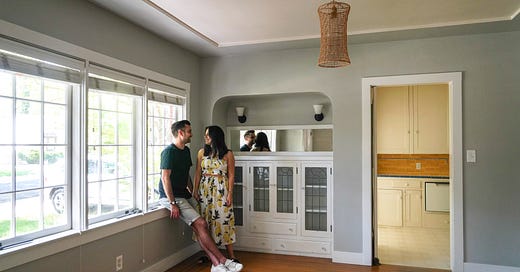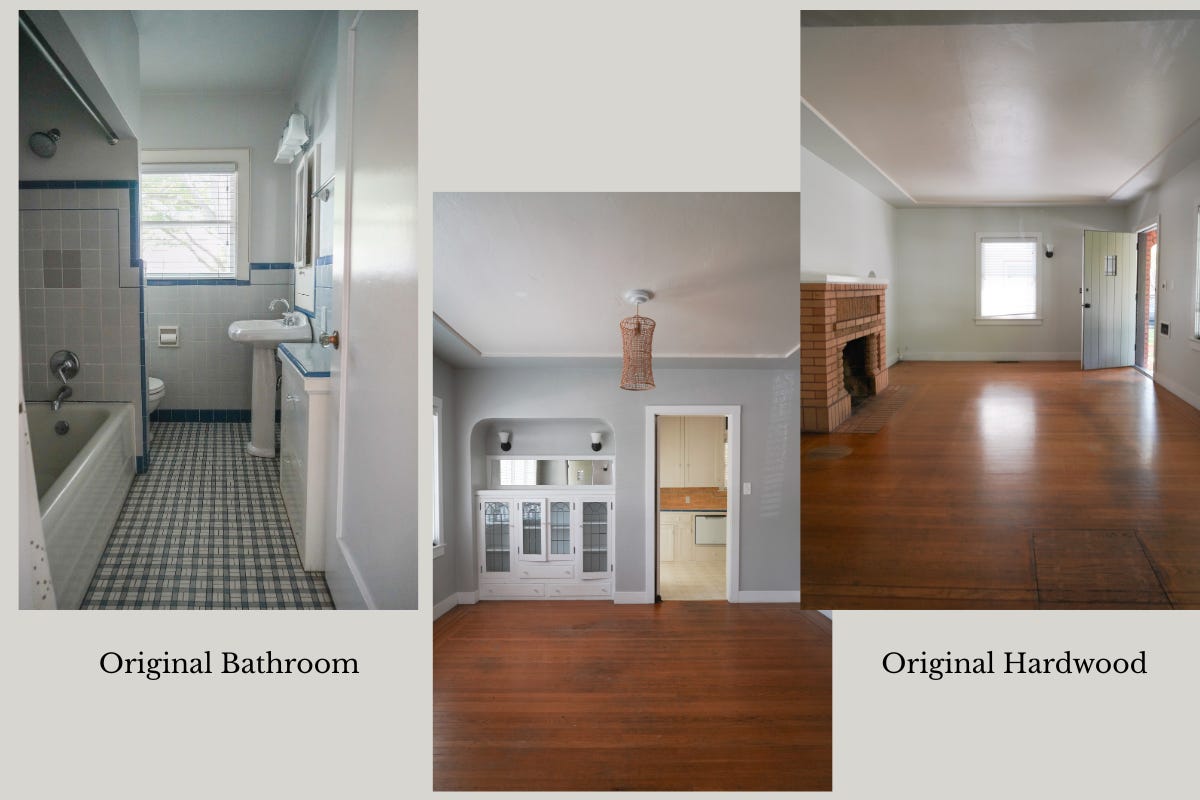Vote is in — I will be sharing insight into our new home, the design process, and the work we will be doing (+ sourcing).
Going to kick off this series by sharing about our background and some renovation takeaways from our first project.
Some Backdrop
Our first home we bought was in 2019, here in Sacramento. It was a nearly 100-year-old home. As a first home purchase, it was overwhelming. The house had original infrastructure with knob/tube wiring, old plumbing, and needed some serious updates. We also had a limited budget, which, as you may guess, for renovations adds a whole new layer of stress.
The beauty of this first house was that it had been lovingly taken care of for its entire lifespan. Structurally, it was sound. The original red fir timber was dry. And the brick was well intact. Owners along the way stewarded the property in a way that meant it could continue to be the brick Tudor it was. But it needed a refresh, the kitchen and bathroom were original to the 1920’s and there was a need for internal upgrades like the electrical and plumbing.
I remember when we signed the papers, thinking through what we had signed up for. My husband’s family background in real estate was an important factor. I want to share this context because we did “GC” our first house renovation ourselves, and give insight into why we did.
My husband’s dad is a general contractor who has built hundreds, if not thousands, of quality homes across California to Idaho. When he saw this house, he reminded us that an older home comes with its quirks, and to know what you’re in for. My father-in-law has an eye for everything — he walks in a room, he can tell you which wall is not straight, which joist needs to be adjusted, and where the mistakes are (it’s like me in a hotel room). It’s truthfully one of the most impressive skillsets I’ve witnessed — we designed and built a few spec houses with him in Idaho a few years back, and it’s a true art to experience. His choice to build things right and by the book (now I see where my husband gets it from) means things last and are done correctly (and subs are held accountable for good work).
Travis (my husband) is an engineer by school, a designer by day, and is getting a master’s in architecture. He’s taught himself dozens of skill sets from the specialty plaster in our bathroom/kitchen to coding and software design. I always joke that if he can’t find someone to do it well, he will learn it himself, today (I chuckle, just today he was re-plumbing the broken faucet in our house). He grew up watching his dad work, who started by building spec houses. He moved more times by age 16 than most do in their lifetime. He was very accustomed to living with exposed sub-floors, projects in their incomplete phases, and the work required.
This first home renovation was our project, and Travis’ dad was happy to chat things over if something came up, which was a huge insurance to know we could always place a phone call. But the work was up to us to do — Travis contracted it all, we designed it together, and he managed + did the work.
All of this experience and background was a big part of the decision to a) renovate ourselves, hiring out only the skilled labor, and b) take on this kind of project. I think we would have done the project regardless, but would have looked to contract it out otherwise because it was quite overwhelming.
This will be short — my background in the home design world is small. I had done the spec houses with Travis, picking out all materials across two homes from plumbing fixtures to stone, which was a very labor-intensive project. It was my first introduction to home design and a reminder that I won’t be picking out materials for anyone else anytime soon.
When it comes to sourcing and materiality, my biggest inspiration is no doubt my travel. Having the opportunity to travel around the world, I’ve drawn inspiration from countless styles of design, especially from hotels. I know what I like when I see it, and sourcing is one of my favorite hunts, second to hotel stays.
Travis jokes that I have an eye for everything, everything very expensive. So my challenge is taking what I love and finding something that is within the budget.
Some Key Takeaways from Our First Renovation
The Work We Did in Our First House:
All new electrical + plumbing (hired out)
Refinished all floors (hired out)
Redid the bathroom and kitchen (Travis did the plastering and shelving / hired out all stone/tile + plumbing)
Opened up the bathroom wall and reframed it (Travis did this)
Repainted in its entirety (including original windows / Travis did all of this.)
Restored all of the 1920s cabinetry throughout (Travis did this).
The Right Subs Matter
If there is one thing that we learned, it's making sure that the subs are doing the work well. Good work is hard to come by, and the best way to find the good ones is by word of mouth or good vetting. Most of our subs have been found through references or Travis doing walk-throughs with the subs themselves.
The trick with subs is knowing whether the work is done well and right. You either need to know how the work needs to be done to keep work accountable, or you need to trust the person enough to know that they’re doing the right work. If you don’t know, this is where a trusted contractor or another in-field expert is helpful.
Get At Least 3 Bids
Just this week, we had to replace part of our air conditioning system. We had three bids, ranging from $8k to $17k. It’s worth the extra time to see where prices are.
Live In It First Before Starting Work
Unless you can’t. When we renovated this house, we bought it in April that year, and Travis stayed here, camped out in the back office on an airbed for 4 months while the project was getting done and he was doing the work. It meant we had never lived in the home before starting the work. While I don’t regret doing the work upfront because it is easier (especially core work like electrical), I think several design decisions could have been better had we lived in it first.
Permits Matter
For so many reasons, like accountability. Get the permit, you’ll thank yourself later. The sub doesn’t want to get the permit? Get a different sub.
Functional Vs. Beauty
Just because it’s beautiful doesn’t mean it’s functional. I learned this the hard way. Find a balance. The questions I’m double asking myself this time around:
Can I, and do I want to, touch this material every day for several years?
Can other people touch this material without me having to give a user warning? How much does this impact the decision?
How do our bodies function in the space? Example: Where is the cabinetry for the glassware in relation to the stove top?
The Order of Work Matters
Do you do the floors or walls first? Things like this matter in the process, so when managing yourself, get the order in place first, as it impacts the flow and speed of the project.
For Budget
Have extra, have extra.
Prioritizing Projects
For us personally, the first project we choose to prioritize is always infrastructure. Mostly because they (can) impact safety, health (updated plumbing, for example), energy costs, and are the most valuable for the dollar spent. If you’re planning to sell your home, rarely is the kind of countertop you chose going to increase the house sale price, but a new HVAC system or roof will. So we prioritize infrastructure for this very reason, and then from there look to make aesthetic upgrades. In an ideal world, both are happening at the same time, but budgets aren’t always there.
It Can Be an Emotional Strain
Let’s not sugarcoat it. It’s a thousand decisions tied to money, time, and work. It’s stressful, but do try to enjoy the process — that’s at least what I’m telling myself this go around.
Home Warranty Can Be Your Best Friend
We bought an old home. The AC, furnace, and water heater were all 25+ years old. We have renewed our $500/year home warranty every single year since we purchased the home — guess what it has paid to cover? A new furnace and a new water heater ($14k in work covered). All of those systems in our house were super old, but they worked great. We knew it was a matter of time before one of the three would need to be replaced, so we kept the home warranty as an insurance policy, and I’m glad we did.









